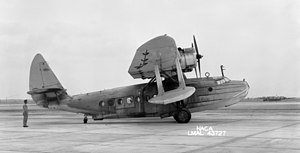Sikorsky S-43
| S-43 (JRS-1) | |
|---|---|
 |
|
| U.S. Navy Sikorsky JRS-1 in 1945 | |
| Role | Flying boat airliner |
| National origin | United States |
| Manufacturer | Sikorsky Aircraft |
| Designer | Igor Sikorsky |
| First flight | 1935 |
| Introduction | 1934 |
| Primary user | Pan American Airways |
| Number built | 53 |
The Sikorsky S-43 was a twin-engine amphibious aircraft manufactured in United States during the 1930s by the American firm Sikorsky Aircraft.
The S-43 first flew in 1935, and was a smaller version of the Sikorsky S-42 "Clipper". It accommodated between 18 and 25 passengers, with a separate two-crew forward cockpit. The S-43 was known as the "Baby Clipper" in airline service.
On April 14, 1936, an S-43 with a 500 kilograms (1,100 lb) payload, piloted by Boris Sergievsky, set an altitude record for amphibious aircraft when it reached an altitude of 27,950 feet above Stamford, Connecticut. Also aboard was designer Igor Sikorsky.
In total, approximately 53 S-43s were built, including examples of the twin-tailed S-43B.
The S-43 was used primarily by Pan American World Airways for flights to Cuba and within Latin America. Two were also flown by Reeve Aleutian Airways in Alaska and three were used by Inter-Island Airways of Hawaii, the predecessor to modern-day Hawaiian Airlines, to ferry Pan-Am Clipper passengers and local residents from Honolulu to the other islands. One aircraft was purchased by Norwegian airline Det Norske Luftfartselskap. Panair do Brasil operated seven aircraft. Five S-43s were used between 1937 and 1945 by the French company Aéromaritime on a colonial airway between Dakar (Senegal) and Pointe-Noire (Congo). Reeve Aleutian Airways owned two S-43s during the 1950s, one operational (N53294 purchased 1948 and trade for G-21 in 1957) and one for spares (fuselage at Alaska Aviation Heritage Museum). Another S-43 was operated in Alaska with an unknown operator, wrecked at Chignik, AK, 1950s.
...
Wikipedia
